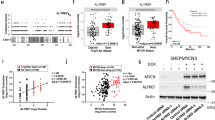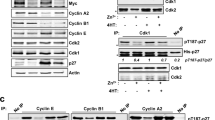Abstract
Vimentin exhibits a complex pattern of developmental- and tissue-specific expression. Since it is aberrantly expressed in metastatic tumors, which have progressed through the epithelial–mesenchymal transition, it has been cited as a marker for tumor progression. Previous studies have indicated that the transcription factor activator protein (AP1) is important in tumor progression. The stable transformation of the MCF7 cell line with the oncogene c-Jun resulted in a cell line (MCF7Jun), which displayed a change in morphology, enhanced migratory and invasive properties, and metastatic behavior. Of the 21 genes whose expression levels were altered in the MCF7Jun cell line, the greatest change in expression occurred for the vimentin gene. Previously, tandem AP1 sites in the promoter were reported to be important for the serum and TPA inducibility of the vimentin gene. However, we find that the AP1 elements only contribute in part to c-Jun activation. Moreover, this activation can be duplicated in COS-1 or S2 cells by expression of c-Jun or TAM67, and is dependent only on the leucine-zipper region of c-Jun. Transient transfection analyses, electrophoretic mobility shift assays, DNA precipitation assays, and coimmunoprecipitation studies suggest that c-Jun is able to synergize with the activator protein Sp1 in binding to GC-box1 to enhance vimentin gene expression.
This is a preview of subscription content, access via your institution
Access options
Subscribe to this journal
Receive 50 print issues and online access
$259.00 per year
only $5.18 per issue
Buy this article
- Purchase on Springer Link
- Instant access to full article PDF
Prices may be subject to local taxes which are calculated during checkout








Similar content being viewed by others
References
Angel P and Karin M . (1991). Biochim. Biophys. Acta, 1072, 129–157.
Bakovic M, Waite KA and Vance DE . (2000). J. Lipid Res., 41, 583–594.
Blaine SA, Wick M, Dessev C and Nemenoff RA . (2001). J. Biol. Chem., 276, 42737–42743.
Briggs J, Chamboredon S, Castellazzi M, Kerry JA and Bos TJ . (2002). Oncogene, 21, 7077–7091.
Brown PH, Kim SH, Wise SC, Sabichi AL and Birrer MJ . (1996). Cell Growth Differ., 7, 1013–1021.
Chen BK and Chang WC . (2000). Proc. Natl. Acad. Sci. USA, 97, 10406–10411.
Chen JH, Vercamer C, Li Z, Paulin D, Vandenbunder B and Stehelin D . (1996). Oncogene, 13, 1667–1675.
Dignam JD, Lebowitz RM and Roeder RG . (1983). Nucleic Acids Res., 11, 1475–1489.
Gilles C and Thompson EW . (1996). Breast J., 2, 83–96.
Hoey T, Weinzierl RO, Gill G, Chen JL, Dynlacht BD and Tjian R . (1993). Cell, 72, 247–260.
Izmailova ES, Snyder SR and Zehner ZE . (2000). J. Interferon Cytokine Res., 20, 13–20.
Izmailova ES, Wieczorek E, Perkins EB and Zehner ZE . (1999a). Gene, 235, 69–75.
Izmailova ES and Zehner ZE . (1999b). Gene, 230, 111–120.
Kardassis D, Papakosta P, Pardali K and Moustakas A . (1999). J. Biol. Chem., 274, 29572–29581.
Li JJ, Cao Y, Young MR and Colburn NH . (2000). Mol. Carcinogen., 29, 159–169.
Lilienbaum A and Paulin D . (1993). J. Biol. Chem., 268, 2180–2188.
Melnikova IN and Gardner PD . (2001). J. Biol. Chem., 276, 19040–19045.
Milde-Langosch K, Bamberger AM, Rieck G, Kelp B and Loning T . (2001). Breast Cancer Res. Treat., 67, 61–70.
Mitchell RA and Bucala R . (2000). Semin. Cancer Biol., 10, 359–366.
Rahmsdorf HJ . (1996). J. Mol. Med., 74, 725–747.
Rinehart-Kim J, Johnston M, Birrer M and Bos T . (2000). Int. J. Cancer, 88, 180–190.
Rittling SR, Coutinho L, Amram T and Kolbe M . (1989). Nucleic Acids Res., 17, 1619–1633.
Saluja D, Vassallo MF and Tanese N . (1998). Mol. Cell Biol., 18, 5734–5743.
Schneider I . (1972). J. Embryol. Exp. Morph., 27, 363–365.
Smith LM, Wise SC, Hendricks DT, Sabichi AL, Bos T, Reddy P, Brown PH and Birrer MJ . (1999). Oncogene, 18, 6063–6070.
Sommers CL, Skerker JM, Chrysogelos SA, Bosseler M and Gelmann EP . (1994). R. Cell Growth Differ., 5, 839–846.
Sommers CL, Walker-Jones D, Heckford SE, Worland P, Valverius E, Clark R, McCormick F, Stampfer M, Abularach S and Gelmann EP . (1989). Cancer Res., 49, 4258–4263.
Stover DM, Carey I, Garzon RJ and Zehner ZE . (1994). Cancer Res., 54, 3092–3095.
Thompson EW, Paik S, Brunner N, Sommers CL, Zugmaier G, Clarke R, Shima TB, Torri J, Donahue S, Lippman ME, Martin GR and Dickson RB . (1992). J. Cell. Physiol., 150, 534–544.
Wang CH, Tsao YP, Chen HJ, Chen HL, Wang HW and Chen SL . (2000). Biochem. Biophys. Res. Commun., 270, 303–310.
Wieczorek E, Lin Z, Perkins EB, Law DJ, Merchant JL and Zehner ZE . (2000). J. Biol. Chem., 275, 12879–12888.
Young MR, Li J-J, Rincon M, Flavell RA, Sathyanarayana BK, Hunziker R and Colburn N . (1999). Proc. Natl. Acad. Sci. USA, 96, 9827–9832.
Zhang X, Diab IH and Zehner ZE . (2003). Nucleic Acids Res., 31, 1–14.
Acknowledgements
We thank Ms Yonghe Li for expert technical assistance. This work was supported by NHLBI, National Institutes of Health (NIH) Grant HL-45422 to ZEZ.
Author information
Authors and Affiliations
Corresponding author
Rights and permissions
About this article
Cite this article
Wu, Y., Zhang, X. & Zehner, Z. c-Jun and the dominant-negative mutant, TAM67, induce vimentin gene expression by interacting with the activator Sp1. Oncogene 22, 8891–8901 (2003). https://doi.org/10.1038/sj.onc.1206898
Received:
Revised:
Accepted:
Published:
Issue Date:
DOI: https://doi.org/10.1038/sj.onc.1206898
Keywords
This article is cited by
-
Regulatory networks driving expression of genes critical for glioblastoma are controlled by the transcription factor c-Jun and the pre-existing epigenetic modifications
Clinical Epigenetics (2023)
-
Long noncoding RNA LINC01111 suppresses pancreatic cancer aggressiveness by regulating DUSP1 expression via microRNA-3924
Cell Death & Disease (2019)
-
Suppression of the androgen receptor function by quercetin through protein–protein interactions of Sp1, c-Jun, and the androgen receptor in human prostate cancer cells
Molecular and Cellular Biochemistry (2010)
-
Sarcomatoid carcinomas of the lung—are these histogenetically heterogeneous tumors?
Virchows Archiv (2006)
-
v-Jun downregulates the alpha 2 (I) collagen target gene indirectly through Sp1/3
Oncogene (2005)



